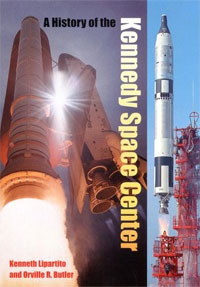Review: A History of the Kennedy Space Centerby Dwayne A. Day
|
| Lipartito and Butler provide an excellent and comprehensive narrative account of NASA’s development of the area. |
When NASA was created in 1958, the agency was assembled out of pieces of several organizations, most importantly the National Advisory Committee on Aeronautics, which had several field centers, including property in Virginia that had been used for missile launches. However, it was clear that Cape Canaveral was the best choice for launching the agency’s rockets. The Cape was already bustling with work on the American ballistic missile program, and NASA started by utilizing Army and Air Force property and equipment. The Apollo program, though, significantly changed this dynamic. NASA acquired substantial amounts of property and began extensive construction in the swamps on Merritt Island. Soon the agency was building one of the largest enclosed structures there to house the mighty Saturn V rocket, the Vehicle Assembly Building. Early workers there faced a horrific mosquito problem, but they also had to contend with alligators and poisonous snakes, not to mention wild boars. After President Kennedy’s assassination the area was renamed Cape Kennedy, but eventually the name was changed back to Cape Canaveral, with NASA’s facility named the Kennedy Space Center, or KSC for short. The major input of cash and skilled workforce to a relatively sleepy southern state had a lasting political impact, and one of Florida’s two senators even flew on a Space Shuttle when he was a congressman.
Lipartito and Butler provide an excellent and comprehensive narrative account of NASA’s development of the area. The opening chapter explains the myriad tasks involved in the preparation of the Saturn V rocket and Apollo spacecraft that carried Apollo 11 to the Moon, illustrating just what happens at a launch site like KSC. It also makes the point that once the rocket lifts off, except for analyzing lessons learned from its preparation, the center’s job is done and everyone turns their full attention to the next launch. Kennedy is an example of technical “operations,” rather than science or research and development.
The authors then recount the initial history of the area, Air Force and NASA occupancy of reclaimed swampland and former orange groves, and then the substantial investments for Apollo. They also discuss the impact of all that construction and technical work on the local region, formerly sleepy fishing and farming communities. They discuss the downturn in work—and the local economy—as the result of the end of the Apollo program, and then changes implemented for the Space Shuttle program, which required some new construction, but largely relied upon the existing Apollo infrastructure. The authors then discuss both Shuttle operations and the two tragic accidents, Challenger in 1986 and Columbia in 2003. In both cases, NASA’s safety culture was identified as a culprit. However, although the vehicles are maintained and readied for launch at KSC, the program is managed from the Johnson Space Center in Houston, and it was Johnson officials who were ultimately culpable for ignoring evidence that the vehicles were in danger.
This is not a dry policy or bureaucratic history. As the authors point out, KSC is in many ways the most physical and blue-collar of the NASA centers. It is where people turn wrenches and stack rockets. But they also note that it takes planning to turn a wrench on something as complex as a rocket or spacecraft. At times the people planning and managing the program, often from far away, resisted input and observations from those doing the work in Florida.
| As the authors point out, KSC is in many ways the most physical and blue-collar of the NASA centers. It is where people turn wrenches and stack rockets. |
Lipartito and Butler have truly done an impressive amount of research, well-documented in footnotes. They have culled a wide array of sources, including official records, memoirs, and local news media accounts that provide not only facts but also flavor to the story. Unfortunately, although they do not admit this, KSC’s documentary records are less than desirable. This may have affected their history in a subtle way: the reality of KSC is that contractors have carried most of the burden at the space center virtually since the beginning, yet the book understates their involvement. That may be an oversight, or it may be an unfortunate situation that all historians face when they have to use the historical records that have been preserved, which do not always reflect the full story. Private contractors are notoriously bad at preserving their own history, and they rarely give outsiders access, thus they often get left out of the history books.
The book is very readable, and manages to bring the subject alive. It is a little dense and specialized for an average reader, but even someone with no knowledge of the history of spaceflight would find it engaging and informative. This is an excellent comprehensive history of the subject.
